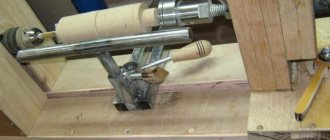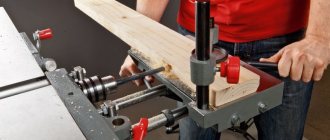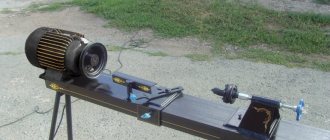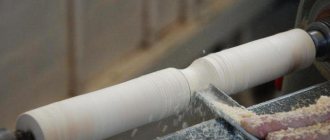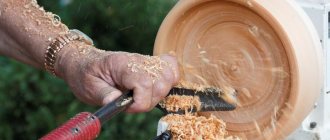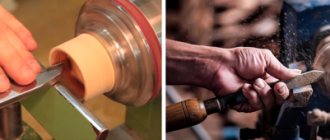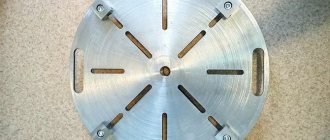Synopsis of the technology lesson “Wood processing technology on a lathe”; 6th grade
Technology lesson in 6th grade on the topic: “Wood processing technology on a lathe.”
Lesson topic:
Wood processing technology on a lathe.
Lesson objectives:
- To consolidate knowledge on the construction of a lathe for wood processing STD-120 M.
- Introduce the types and purposes of chisels for woodworking.
- To consolidate knowledge on the use of devices for securing workpieces.
- Create conditions for the development of general educational and special skills. 5. To develop polytechnic, general education, and production skills in schoolchildren. 6. Foster a respectful attitude towards work.
Lesson type:
combined with the use of ICT.
Object of labor
:
1. Lathe for wood processing STD-120M. 2. Chisels for woodworking. 3. Devices for securing workpieces.
Equipment:
machine STD-120M, model of a lathe, chisels, textbook “Technology” - grade 7, parts made on machines, test cards, multi-media projector, screen.
Form of training organization:
individual, group, frontal.
Teaching methods:
- verbal; 2. research; 3. demonstrative; 4. partially search;
DURING THE CLASSES:
I. Organizational stage.
1.1. Greeting students and checking attendance
- Checking work clothes and readiness for class.
1.3. Appointment of duty officers. 1.4. Induction training.
Lesson topic message.
Formulate the purpose of the lesson based on its topic. ( Write down the topic of the lesson in your notebooks).
2. Motivation.
Conversation to review theoretical information:
What tools did we use when processing wood on a wood lathe? (Maisel, Reyer). What devices are used when processing wood on a wood lathe? (cartridge, trident, faceplate).
3. Updating knowledge
Today you must learn to distinguish between the types and purposes of wood turning tools, the types of work they perform, and learn how to correctly use devices for securing workpieces. Turning simple parts on a wood lathe.
4
.
Checking homework.
Testing.
Students are offered test cards. Peer review
5. Questions for students:
1. Purpose of the STD-120M machine? 2. Name the main parts of the STD-120M machine on the screen and what do they serve?
3.What movement in the machine is called the main one? 4.What is the auxiliary movement called? 5. What is the purpose of the headstock and tailstock of a lathe?
6. What types of wood are best used for turning?
6. Explanation of new material.
Working methods and workpiece preparation.
Anyone who knows the structure of the machine and the rules of safe operation can learn to work on a lathe, since this process does not have complex operations and involves removing the surface layer in the form of chips from the workpiece being processed. In this case, the workpiece being processed rotates, and the chisel is moved relative to the workpiece, resting on the tool rest. Preparation of the workpiece for turning is of great importance. If the end of the workpiece has the shape of a square, then diagonals are drawn at the ends to find the center. Then, using a plane, the ribs are cut off, giving the workpiece an octagonal shape. At one end of the workpiece, a cut is made with a depth of 2-3 mm for a trident. After this, the workpiece is fixed on the machine, taking into account that the distance between the workpiece and the tool rest should be minimal (2-3 mm)
Types and purpose of chisels Turning the workpiece is done using special chisels. Semicircular chisels (a, c) are used for rough profile processing of wood, and chisels with oblique (angular) cutting edges (b) are used for finishing surfaces, as well as for turning cones and trimming ends. Chisels must be sharp and have intact handles. Only the teacher can sharpen chisels!
On the screen we demonstrate the types of chisels.
Routing. Before starting turning, study the technological map for processing the product. The technological map can be made in the form of a table and contains the sequence of work, images in the form of a drawing or picture, and can also indicate the types of equipment and tools.
7
.
An example of a technological map
| № | Sequence of work | Image | Equipment and tools |
| Prepare the workpiece. | Pencil, ruler, square, hacksaw. | ||
| Mark the workpiece and sharpen the edges. | Pencil, ruler, surface planer, plane, workbench, awl. |
8. Rules for working on the lathe (preferably near the machine with a practical demonstration of the process) Working on a lathe is carried out wearing safety glasses. After turning on the machine, take the chisel in your right hand, place it on the tool rest without touching the workpiece, and press it onto the tool rest with your left hand from above. First, rough turning is performed with a semicircular chisel. At the same time, slowly bring the blade to the rotating workpiece and smoothly move the chisel to the left and right to remove the chips. Finish turning is performed with an oblique chisel. In this case, the chisel is rested with its edge on the tool rest from the side of the obtuse angle. Do not allow the sharp corner of the chisel to cut into the workpiece - this can lead to the ejection of the chisel and cause injury! The workpiece dimensions are controlled after the machine is turned off and the spindle is completely stopped. If necessary, the part is processed using a grinding block. After stopping the machine, the workpiece is removed, the excess ends are cut off with a saw and cleaned with sandpaper or a file.
9. Safety rules. 1. Do not turn on the machine without the teacher’s permission. 2. Check the workpiece, it should be free of knots and cracks. 3. Securely fasten the workpiece. 4. There should be nothing superfluous in the workplace. 5.Check the working tool. The handles of chisels should be free of cracks and firmly seated. 6. Tuck in clothes. Fasten all buttons. Tuck long hair under the beret. 7.Before starting the machine, put on safety glasses. 8. Monitor the distance between the tool rest and the workpiece. When it increases, move the tool rest, stopping the operation of the machine. 9. During work, do not be distracted, do not leave the machine. 10. All adjustment operations should be carried out only when the machine is turned off. 11. Do not stop the rotation of the workpiece with your hands. 12. If any malfunctions are detected, immediately turn off the machine and inform the teacher. 10. Practical activities
Under the supervision of the teacher, students perform training work.
11. Repetition and generalization of material.
Solving test card tasks
Assessment of students' practical work; analysis of typical errors.
12. Homework assignment.
Select an object to be turned on the machine and complete a technological map for its production. Review the rules for safe operation of the machine.
13. Lesson summary.
Now let's summarize the lesson.
What skills were reinforced in the lesson?
What subjects did you need knowledge of during the lesson? What new did you learn in today's lesson?
14. Cleaning workplaces.
End of form
Synopsis of a technology lesson in 6th grade. Wood turning.
Technology lesson in 6th grade. Wood turning
"Study of wood turning technology on a lathe." Synopsis of a technology lesson in 6th grade . Purpose: Studying the technology of turning wooden products on a lathe. Objectives: To familiarize yourself with the techniques of working on a wood lathe, to study safety rules when working, to develop skills in organizing practical activities and self-control when performing technological operations, to cultivate labor discipline, and interest in the professions of a joiner and carpenter. Purpose: The lesson notes will be useful for technology teachers when studying the techniques of artistic wood processing using a lathe. This lesson is taught in 6th grade after studying the structure of a wood lathe. Material and technical equipment: — lathe STD-120; - chisels for turning wood; - wooden blank; -posters, technological maps Progress of the lesson 1 Introductory speech by the teacher. In the modern world, the profession of a carpenter is in great demand because it is multidisciplinary. A carpenter makes furniture, participates in construction: in the manufacture and installation of doors and windows, cutting in locks and handles, wall cladding, as well as in the manufacture of various wood products. A carpenter's workplace is most often a workbench or its modern modifications. The carpenter is well versed in drawings, he himself designs and manufactures various products from wood and materials replacing it. The words from V. Mayakovsky’s poem are not outdated: “The necessary workers are joiners and carpenters...” In his work, a carpenter uses not only hand tools, but also various woodworking machines. We studied the structure of one of these machines in the last lesson. 2. Repetition of the material covered on the topic “Design of a wood lathe” Card (Given to students or displayed on the screen)
Tasks on the card: 1. List the names of the parts of the STD-120 machine 2. Indicate (orally, if on the screen), transfer (if on the card) the numbers from the general view (a) to the kinematic diagram (b) Answers for task No. 1: 1- bed; 2-front headstock; 3-shaft electric motor; 4-spindle; 5-belt drive; 6-handrest with carriage; 7-tailstock; 8-buttons “Start” and “Stop” Questions “shootout” (quickly, briefly): 1. A Russian who developed and manufactured more than 40 designs of various lathes... (A.K. Narvatov) 2. What movement in the machine is called the main one? (Rotational) 2.What is the auxiliary movement called? (Progressive) 3. What is the purpose of the headstock and tailstock of a lathe? (The front headstock imparts rotational motion to the workpiece, and the rear headstock serves to compress the workpiece during rotation). 4 Basic rules for safe work - do not turn on the machine without the teacher’s permission; — do not turn on the machine without a guarded belt drive; — do not place tools or other objects on the machine; - Immediately report any malfunctions to the teacher. - do not lean on the machine 3. Communication of new material 1. Working methods and preparation of the workpiece. Anyone who knows the structure of the machine and the rules of safe operation can learn to work on a lathe, since this process does not have complex operations and involves removing the surface layer in the form of chips from the workpiece being processed. In this case, the workpiece being processed rotates, and the chisel is moved relative to the workpiece, resting on the tool rest.
Preparation of the workpiece for turning is of great importance. If the end of the workpiece has the shape of a square (A = B), then diagonals are drawn at the ends to find the center. Then, using a plane, the ribs are cut off, giving the workpiece an octagonal shape.
At one end of the workpiece, a cut is made with a depth of 2-3 mm for a trident. After this, the workpiece is fixed on the machine, taking into account that the distance between the workpiece and the tool rest should be minimal (2-3 mm) 2. Types and purpose of chisels Turning the workpiece is done using special chisels.
Semicircular chisels (a, b) are used for rough profile processing of wood, and chisels with oblique (angular) cutting edges (c) are used for finishing surfaces, as well as for turning cones and trimming ends. Chisels must be sharp and have intact handles. Only the teacher can sharpen chisels! 3. Technological map. Before starting turning, study the technological map for processing the product. The technological map can be made in the form of a table and contains the sequence of work, images in the form of a drawing or picture, and the types of equipment and tools can also be indicated. An example of a technological map
4. Rules for working on the lathe (preferably near the machine with a practical demonstration of the process) Working on a lathe is carried out wearing safety glasses. After turning on the machine, take the chisel in your right hand, place it on the tool rest without touching the workpiece, and press it against the tool rest with your left hand (photo above). First, rough turning is performed with a semicircular chisel. At the same time, slowly bring the blade to the rotating workpiece and smoothly move the chisel to the left and right to remove the chips. Finish turning is performed with an oblique chisel. In this case, the chisel is rested with its edge on the tool rest from the side of the obtuse angle.
Do not allow the sharp corner of the chisel to cut into the workpiece - this can lead to the ejection of the chisel and cause injury! The workpiece dimensions are controlled after the machine is turned off and the spindle is completely stopped. If necessary, the part is processed using a grinding block.
After stopping the machine, the workpiece is removed, the excess ends are cut off with a saw and cleaned with sandpaper or a file. 4. Training work. Before allowing a student to work, the teacher provides instructions on the rules of safe work, enters them in a special journal, where he signs for this instruction, and the student signs for receiving the instructions. Safety rules 1. Do not turn on the machine without the teacher’s permission. 2. Check the workpiece, it should be free of knots and cracks. 3. Securely fasten the workpiece. 4. There should be nothing superfluous in the workplace. 5.Check the working tool. The handles of chisels should be free of cracks and firmly seated. 6. Tuck in clothes. Fasten all buttons. Tuck long hair under the biret. 7.Before starting the machine, put on safety glasses. 8. Monitor the distance between the tool rest and the workpiece. When it increases, move the tool rest, stopping the operation of the machine. 9. During work, do not be distracted, do not leave the machine. 10. All adjustment operations should be carried out only when the machine is turned off. 11. Do not stop the rotation of the workpiece with your hands. 12. If any malfunctions are detected, immediately turn off the machine and inform the teacher. Students perform training work under the supervision of a teacher. 5. Summing up. Homework assignment. -Select an object for turning on the machine and complete a technological map for its production. -Know the rules for safe operation of the machine. Literature Technology. Technical work, 6th grade: a textbook for students of general education institutions, edited
Under the guidance of Konstantin Pavlovich Plygun, teacher of the first qualification category.

